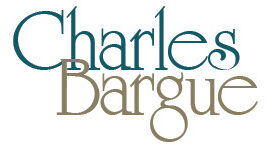Welcome to the Print House of Mr. Lemercier around 1840
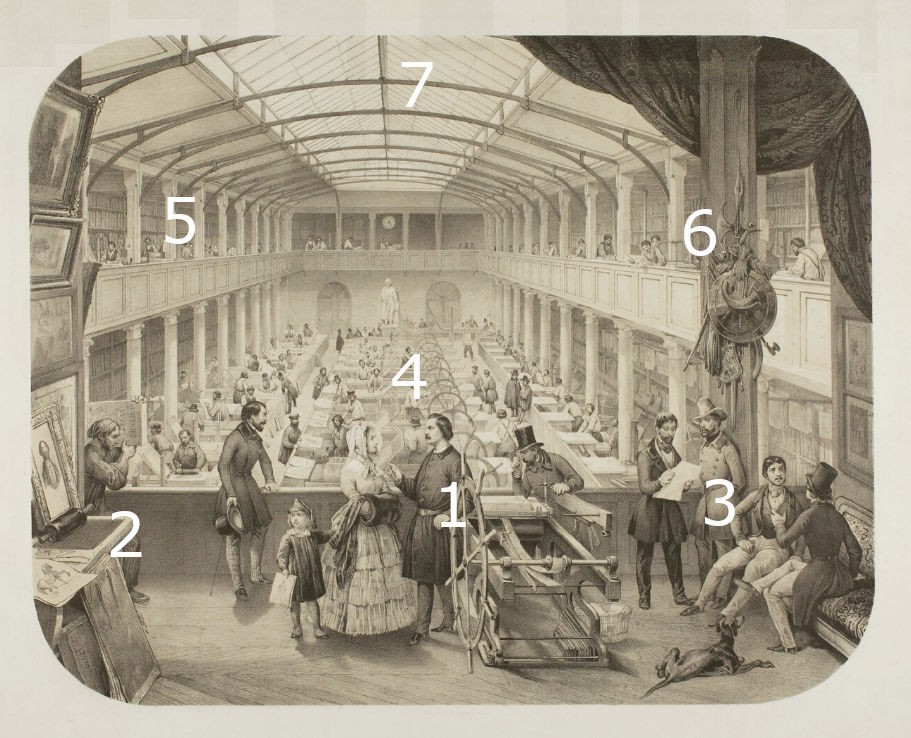
We will take you on a tour of the Lemercier workshop in the order of the numbers shown in this image.
Scroll down the page to start…
1
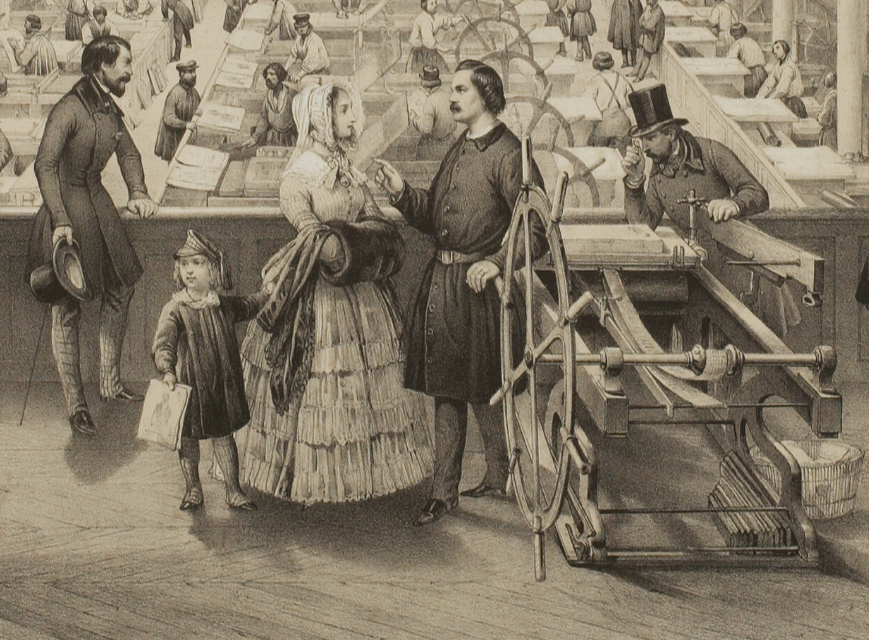
Here is (in the center) Mr. Lemercier, owner of this magnificent print shop located in the heart of Paris, 57 rue de Seine. He is wearing his lithographer’s work clothes. He is leaning on a press that we call a “horned beast”. He is proud of his printing shop that he founded alone by dint of perseverance.
He is talking to a lady whose child has received a printed image, something still extraordinary at that time. A customer is waiting for his turn while observing the lithographers at work. On the other side, a man carefully scrutinizes the design of a lithographic stone in place on the press. It is the precision of the details that interests this visitor.
2
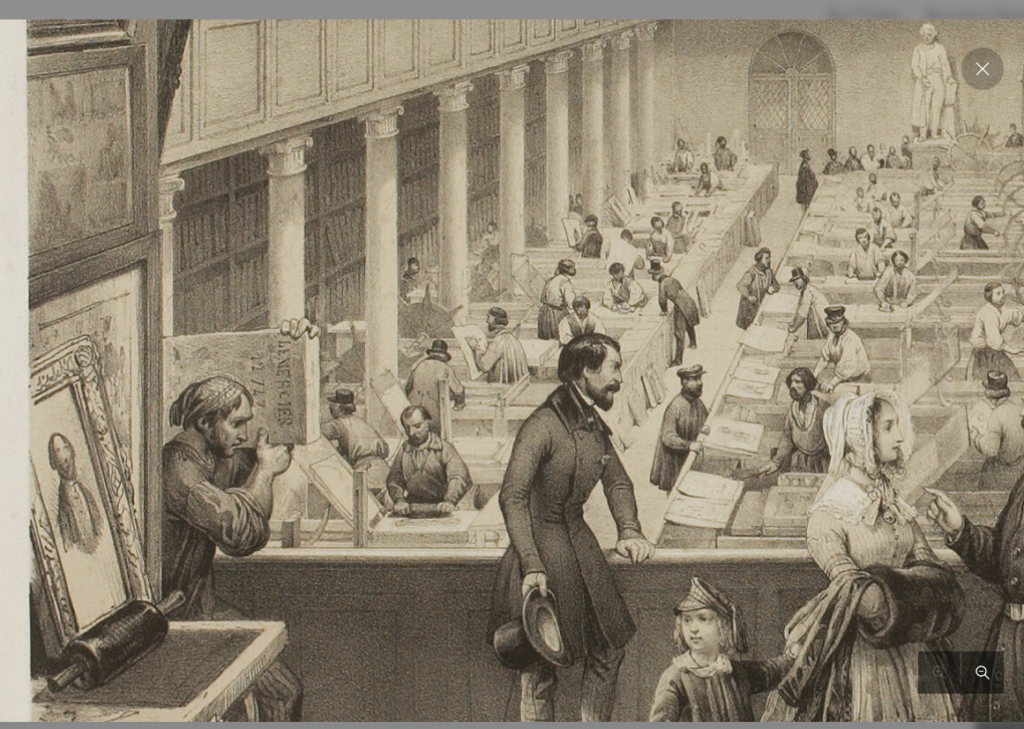
On the left a worker is carrying a heavy lithographic stone. These stones came from Bavaria for their unique qualities. They were extracted from quarries forming fine limestone slabs, which had already been well spotted by Sennefelder who invented lithography about a century earlier. In the foreground, an inking table and a leather roll were used to illustrate the explanation of lithographic magic. Mr. Lemercier had started at the age of 12 as a stone carrier before climbing the ladder of the profession and becoming the greatest printer in Paris.
3
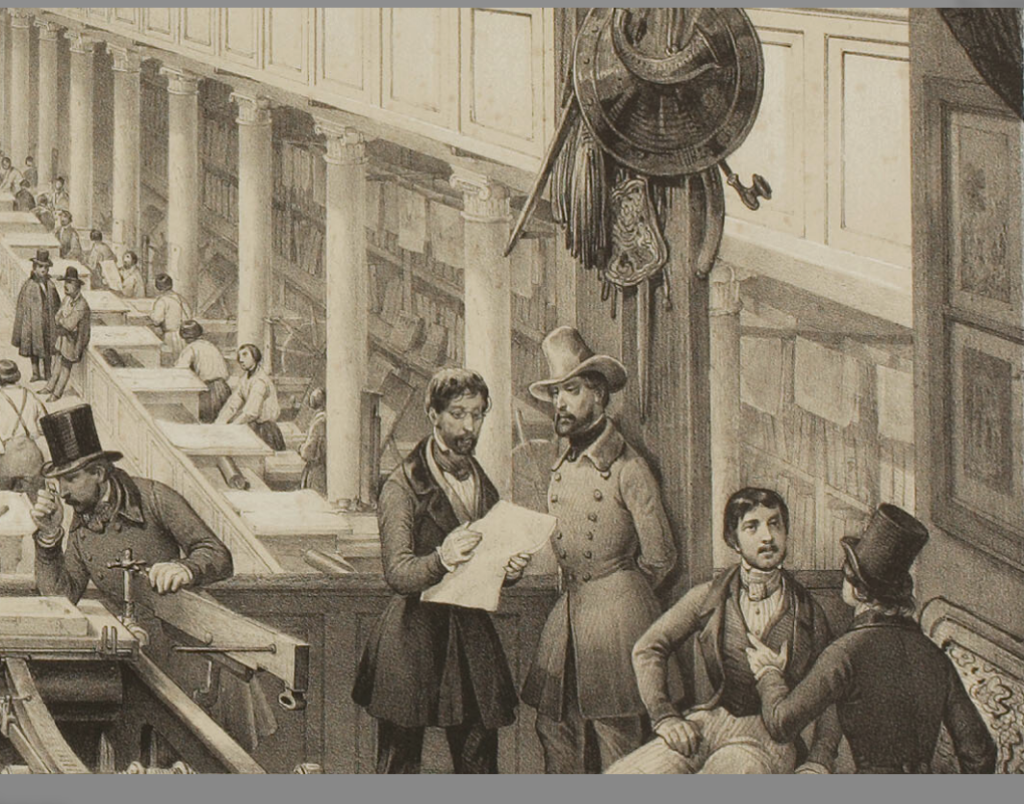
On the right side, customers wait and chat while a man looks at a document brought by a customer. This man could be Alfred Lemercier, the nephew of the owner who worked with his uncle and took over in 1887.
On the lower level we see more presses and hanging sheets of paper drying after being prepared for a transfer print.
4
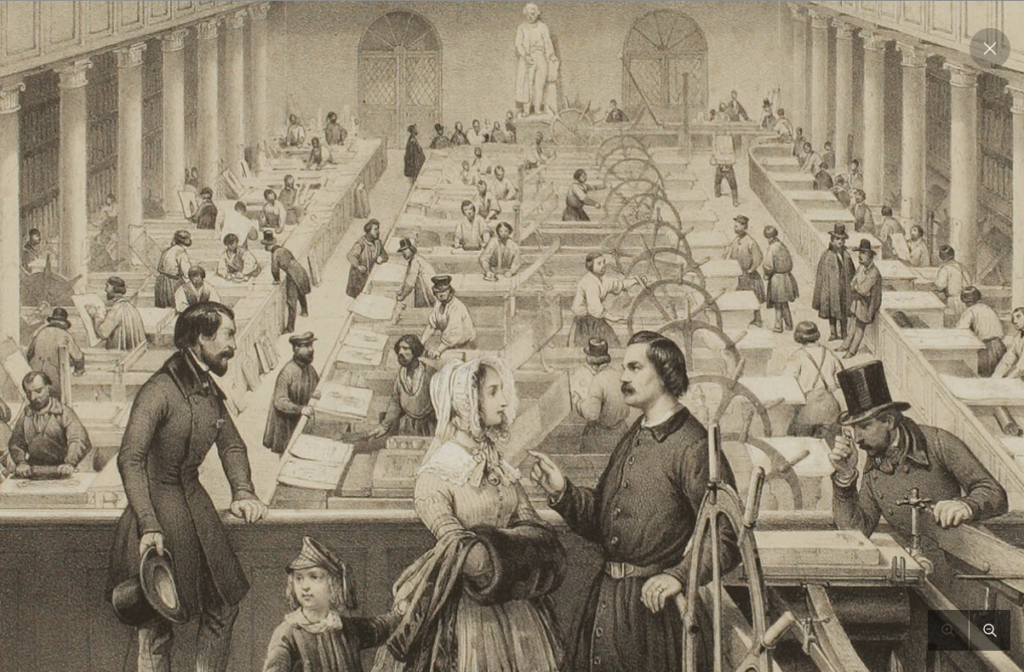
On the lower level, the impressive number of presses and employees shows us the notoriety of this establishment. The two doors at the back are the ones leading to rue Mazarine. In the middle of the room, a statue adorns the press room. There is no indication of who the figure is that seems to be watching over the whole workshop.
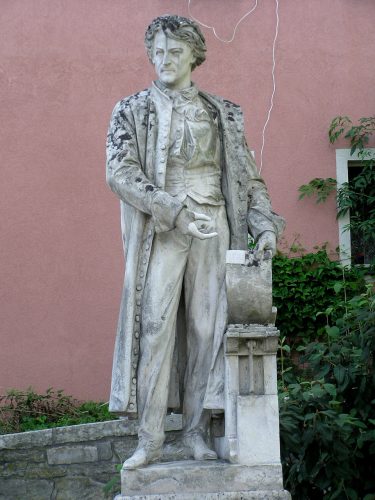
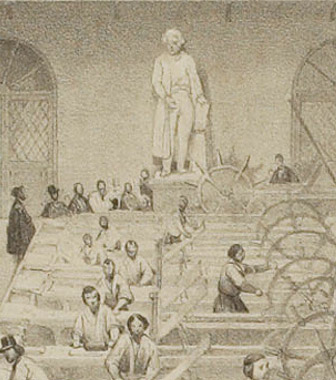
Lemercier had learned lithography from Knecht, Knecht from Sennefelder, so a little research on both characters allowed us to identify Aloïs Sennefelder whose original statue is still visible in Germany
5
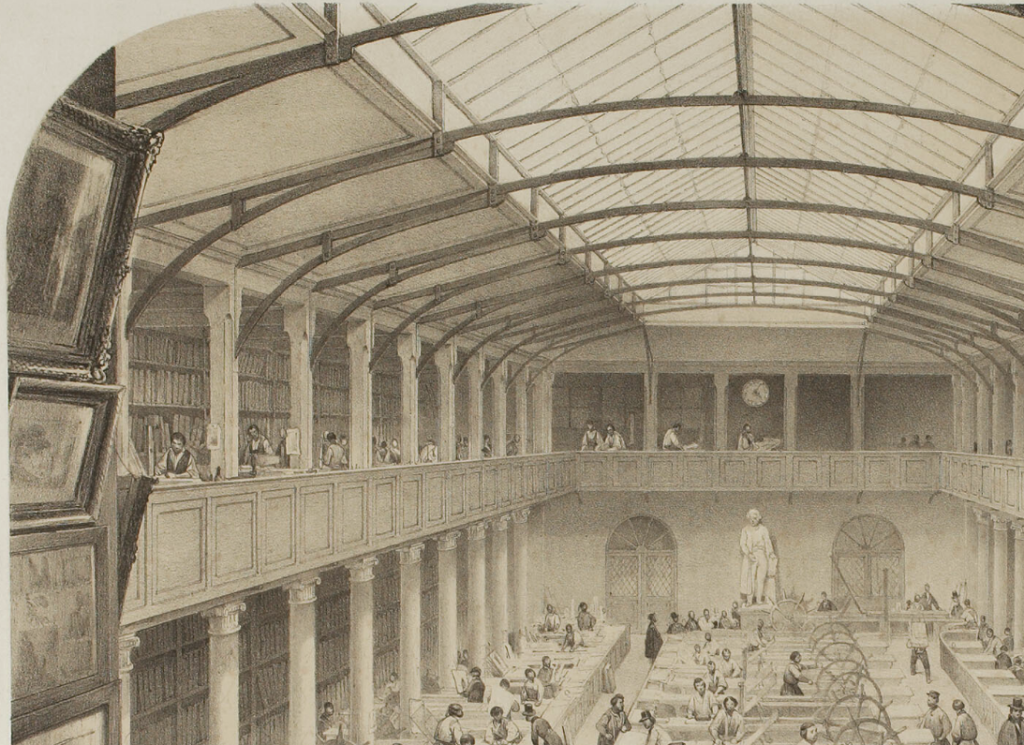
Above the press room, a passageway supported by a string of columns shelters the draftsmen on stone. Looking at their models in mirrors, they copy the original drawing on the stone with an amazing fidelity. But what are all these books stored in a sort of gigantic library?
6

They are not books but stones! The Lemercier lithographic printing house had more than 30,000 of them. Note that all the designers are upstairs to take advantage of the glass roof and have their backs to us because they are right-handed for the majority whereas on the left side they were facing us.
7

Let’s admire the magnificent metal structure created by Jean Eiffel, the engineer who built the tower that bears his name. It supports the glass roof allowing the light to flood the whole workshop.
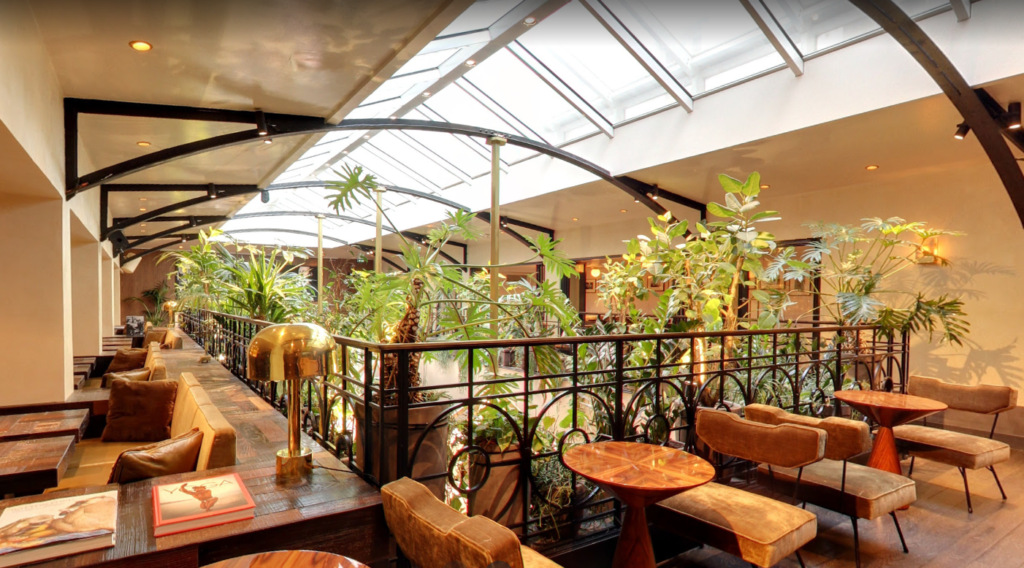
Formerly an open-air “Jeu de Paume” game hall, the place later became the famous Parisian cabaret l’Alcazar and is now a Parisian brasserie still called l’Alcazar. The general volume has remained, the columns have been modernized, but under the metal structure there is still all the emotion of a place that has already been famous three times.

Joseph-Rose Lemercier (1803-1887) is one of the most important Parisian printers-lithographers of the 19th century. He worked for the greatest publishers and artists of his time. He played an important role in the diffusion and the generalization of the process of photolithography which made it possible to transfer a photographic image on a lithographic stone and to carry out thanks to that impressions with the printing ink of this image.
Biography
Of modest origin, son of a Parisian basket maker, he was born in Paris on July 6th 18031 and died on January 1st 1887. He married Marguerite Drancy in 1824 and had two children who died in infancy.
He was apprenticed to Edouard Knecht, nephew and successor of Aloys Senefelder, the inventor of lithography. In 1828, he started his own business and in 1831, he moved to 57, rue de Seine, in a former game of paume.
In 1852, the Lemercier et Cie printing company had 80 presses and employed 180 workers.
Willkommen in der Druckerei von Herrn Lemercier um 1840

Wir nehmen Sie mit auf einen Rundgang durch die Lemercier-Werkstatt, und zwar in der Reihenfolge der Nummern, die in diesem Bild gezeigt werden.
Scrollen Sie auf der Seite nach unten, um zu beginnen…
1

Hier ist (in der Mitte) Herr Lemercier, Inhaber dieser großartigen Druckerei im Herzen von Paris, 57 rue de Seine. Er trägt die Arbeitskleidung eines Lithographen. Er stützt sich auf eine Presse, die wir als “gehörntes Tier” bezeichnen. Er ist stolz auf seine Druckerei, die er allein durch seine Beharrlichkeit gegründet hat.
Er unterhält sich mit einer Frau, deren Kind ein gedrucktes Bild erhalten hat, was zu dieser Zeit noch außergewöhnlich war. Ein Kunde wartet, bis er an der Reihe ist, während er die Lithographen bei der Arbeit beobachtet. Auf der anderen Seite prüft ein Mann sorgfältig den Entwurf eines Steindrucks, der auf der Presse liegt. Es ist die Präzision der Details, die diesen Besucher interessiert.
2

Auf der linken Seite trägt ein Arbeiter einen schweren Lithografiestein. Diese Steine kamen wegen ihrer einzigartigen Eigenschaften aus Bayern. Sie wurden in Steinbrüchen zu feinen Kalksteinplatten abgebaut, die bereits von Sennefelder, dem Erfinder der Lithografie, etwa ein Jahrhundert zuvor gut erkannt worden waren. Im Vordergrund wurden ein Färbetisch und eine Lederrolle zur Veranschaulichung der Erklärung der lithografischen Magie verwendet. Herr Lemercier hatte im Alter von 12 Jahren als Steinträger begonnen, bevor er die Karriereleiter erklomm und zum größten Drucker von Paris aufstieg.
3

Auf der rechten Seite warten die Kunden und unterhalten sich, während ein Mann ein von einem Kunden mitgebrachtes Dokument prüft. Bei diesem Mann könnte es sich um Alfred Lemercier handeln, den Neffen des Besitzers, der mit seinem Onkel zusammenarbeitete und die Firma 1887 übernahm.
Im unteren Stockwerk sehen wir weitere Pressen und hängende Papierbögen, die nach der Vorbereitung für einen Transferdruck trocknen.
4

Auf der unteren Ebene zeigt die beeindruckende Anzahl von Pressen und Angestellten die Berühmtheit dieses Hauses. Die beiden Türen auf der Rückseite führen zur Rue Mazarine. In der Mitte des Raumes schmückt eine Statue den Pressesaal. Es gibt keinen Hinweis darauf, wer die Figur ist, die über die gesamte Werkstatt zu wachen scheint.


Lemercier hatte die Lithografie bei Knecht gelernt, Knecht bei Sennefelder, so dass eine kleine Recherche über beide Personen es uns ermöglichte, Aloïs Sennefelder zu identifizieren, dessen Originalstatue noch in Deutschland zu sehen ist
5

Über dem Drucksaal befindet sich ein von einer Säulenreihe gestützter Gang, in dem die Zeichner auf Stein arbeiten. Sie betrachten ihre Modelle in Spiegeln und kopieren die Originalzeichnung mit erstaunlicher Genauigkeit auf den Stein. Aber was sind das für Bücher, die in einer Art gigantischer Bibliothek aufbewahrt werden?
6

Es sind keine Bücher, sondern Steine! Die Steindruckerei Lemercier hatte mehr als 30.000 davon. Man beachte, dass alle Designer oben sind, um die Vorteile des Glasdachs zu nutzen, und uns den Rücken zuwenden, weil die meisten von ihnen Rechtshänder sind, während sie uns auf der linken Seite zugewandt waren.
7

Bewundern Sie die großartige Metallstruktur von Jean Eiffel, dem Ingenieur, der den nach ihm benannten Turm gebaut hat. Sie stützt das Glasdach, durch das das Licht in die gesamte Werkstatt fällt.

Ehemals eine Freiluft-Spielhalle des “Jeu de Paume”, wurde der Ort später das berühmte Pariser Cabaret l’Alcazar und ist heute eine Pariser Brasserie, die immer noch l’Alcazar heißt. Das allgemeine Volumen ist erhalten geblieben, die Säulen wurden modernisiert, aber unter der Metallstruktur ist immer noch die ganze Emotion eines Ortes zu spüren, der bereits dreimal berühmt war.

Joseph-Rose Lemercier (1803-1887) ist einer der bedeutendsten Pariser Drucker-Lithographen des 19. Jahrhunderts. Er arbeitete für die größten Verleger und Künstler seiner Zeit. Er spielte eine wichtige Rolle bei der Verbreitung und Verallgemeinerung des Verfahrens der Fotolithografie, das es ermöglichte, ein fotografisches Bild auf einen lithografischen Stein zu übertragen und dank dessen Abdrücke mit der Druckfarbe von diesem Bild zu machen.
Lebenslauf
Er stammte aus bescheidenen Verhältnissen, war Sohn eines Pariser Korbmachers, wurde am 6. Juli 18031 in Paris geboren und starb am 1. Januar 1887. Er heiratete 1824 Marguerite Drancy und hatte zwei Kinder, die im Säuglingsalter starben.
Er ging bei Edouard Knecht, dem Neffen und Nachfolger von Aloys Senefelder, dem Erfinder der Lithografie, in die Lehre. 1828 machte er sich selbständig und zog 1831 in die 57, rue de Seine, in ein ehemaliges Spiel der Paume.
Im Jahr 1852 verfügte die Druckerei Lemercier et Cie über 80 Druckmaschinen und beschäftigte 180 Mitarbeiter.
